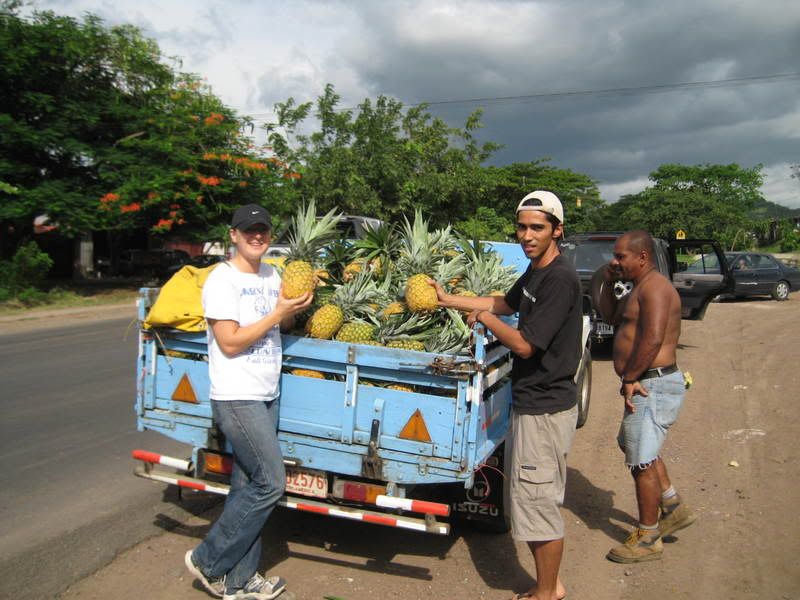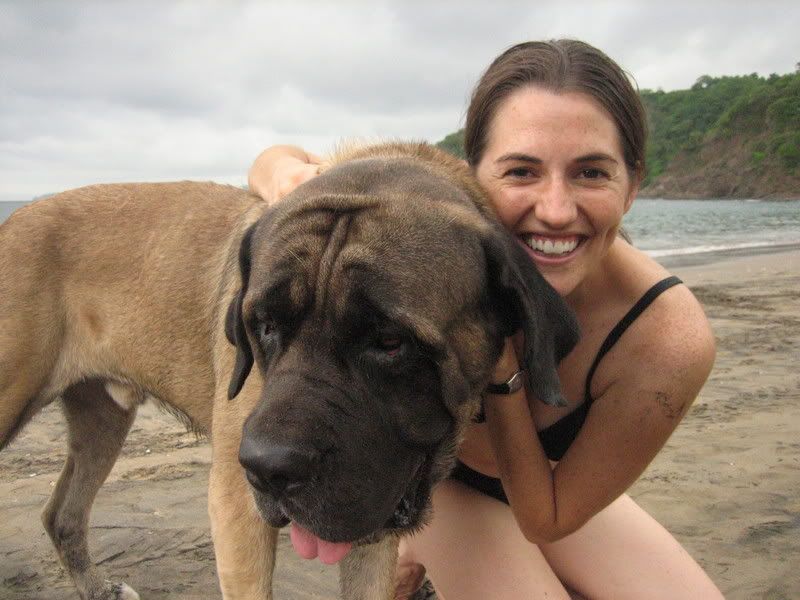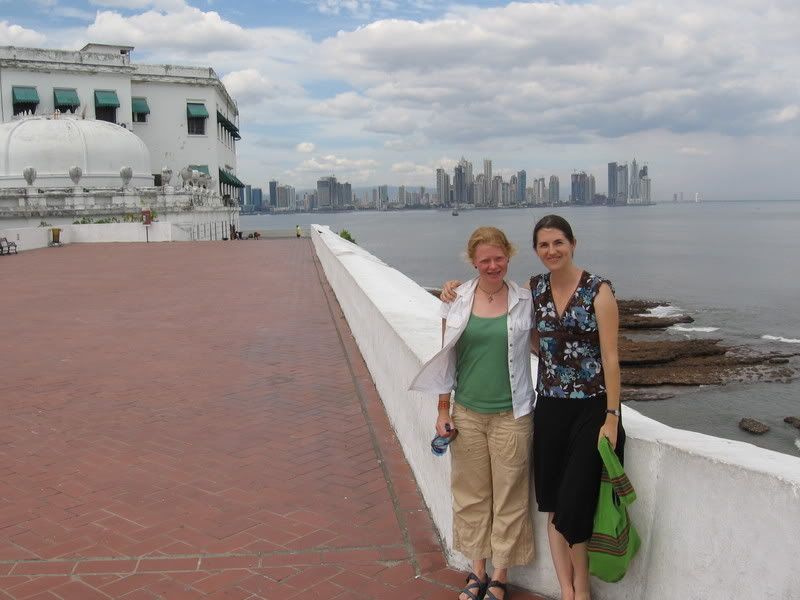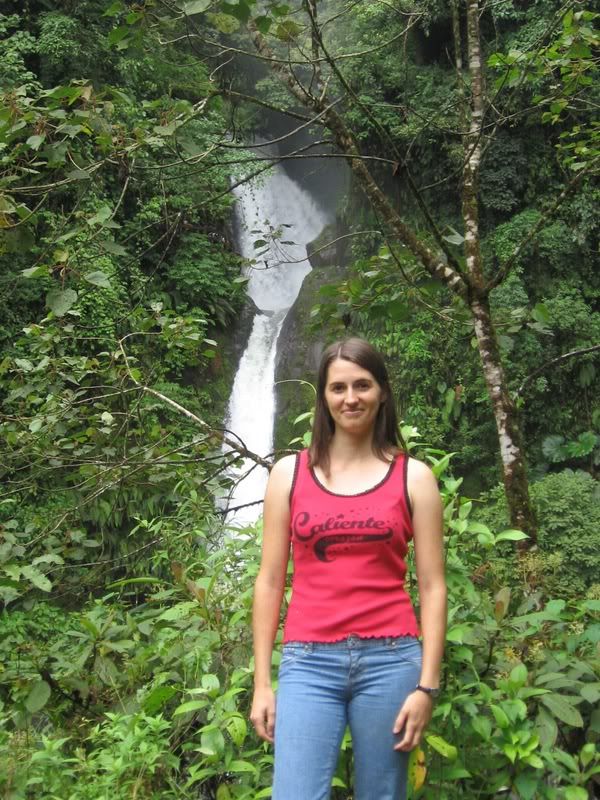 This is the buzz word here lately, and one only wishes the acronym stood for Tender Loving Care, because it is one of the most polemic debates this country has ever seen. Yet, TLC stands for el Tratado de Libre Comercio or the free trade agreement with the United States known as CAFTA. Costa Rica is the only Central American country that still has yet to ratify the agreement. However, the decision is now in the hands of the people….with an upcoming referendum. On October 7, Costa Rica citizens will go to the polls to vote SI or NO al TLC. The debate has enveloped the country in the last months and there is propaganda from both sides everywhere; there have been rallies, demonstrations, marches, buttons, and televised debates. The apartment below us happens to be one of the headquarters for the SI campaign and last week we were awakened to sounds of glass breaking as a group threw rocks through the window and sprayed the building with the words “NO AL TLC”. Those against the treaty claim that Costa Rica will never be able to compete with the imports that will enter tax free if the treaty is signed. The public services such as electricity and water will become privatized, meaning that prices will go up. Those who stand behind the SI banner, argue that the treaty will bring new jobs and possibilities to Costa Rica. In their opinion Costa Rica must sign the treaty if it wants to continue to compete in the global market. It is hard to say what will happen on October 7, but one thing is for sure, it is a pivotal time in the history of this nation.
This is the buzz word here lately, and one only wishes the acronym stood for Tender Loving Care, because it is one of the most polemic debates this country has ever seen. Yet, TLC stands for el Tratado de Libre Comercio or the free trade agreement with the United States known as CAFTA. Costa Rica is the only Central American country that still has yet to ratify the agreement. However, the decision is now in the hands of the people….with an upcoming referendum. On October 7, Costa Rica citizens will go to the polls to vote SI or NO al TLC. The debate has enveloped the country in the last months and there is propaganda from both sides everywhere; there have been rallies, demonstrations, marches, buttons, and televised debates. The apartment below us happens to be one of the headquarters for the SI campaign and last week we were awakened to sounds of glass breaking as a group threw rocks through the window and sprayed the building with the words “NO AL TLC”. Those against the treaty claim that Costa Rica will never be able to compete with the imports that will enter tax free if the treaty is signed. The public services such as electricity and water will become privatized, meaning that prices will go up. Those who stand behind the SI banner, argue that the treaty will bring new jobs and possibilities to Costa Rica. In their opinion Costa Rica must sign the treaty if it wants to continue to compete in the global market. It is hard to say what will happen on October 7, but one thing is for sure, it is a pivotal time in the history of this nation.
Monday, October 1, 2007
TLC
 This is the buzz word here lately, and one only wishes the acronym stood for Tender Loving Care, because it is one of the most polemic debates this country has ever seen. Yet, TLC stands for el Tratado de Libre Comercio or the free trade agreement with the United States known as CAFTA. Costa Rica is the only Central American country that still has yet to ratify the agreement. However, the decision is now in the hands of the people….with an upcoming referendum. On October 7, Costa Rica citizens will go to the polls to vote SI or NO al TLC. The debate has enveloped the country in the last months and there is propaganda from both sides everywhere; there have been rallies, demonstrations, marches, buttons, and televised debates. The apartment below us happens to be one of the headquarters for the SI campaign and last week we were awakened to sounds of glass breaking as a group threw rocks through the window and sprayed the building with the words “NO AL TLC”. Those against the treaty claim that Costa Rica will never be able to compete with the imports that will enter tax free if the treaty is signed. The public services such as electricity and water will become privatized, meaning that prices will go up. Those who stand behind the SI banner, argue that the treaty will bring new jobs and possibilities to Costa Rica. In their opinion Costa Rica must sign the treaty if it wants to continue to compete in the global market. It is hard to say what will happen on October 7, but one thing is for sure, it is a pivotal time in the history of this nation.
This is the buzz word here lately, and one only wishes the acronym stood for Tender Loving Care, because it is one of the most polemic debates this country has ever seen. Yet, TLC stands for el Tratado de Libre Comercio or the free trade agreement with the United States known as CAFTA. Costa Rica is the only Central American country that still has yet to ratify the agreement. However, the decision is now in the hands of the people….with an upcoming referendum. On October 7, Costa Rica citizens will go to the polls to vote SI or NO al TLC. The debate has enveloped the country in the last months and there is propaganda from both sides everywhere; there have been rallies, demonstrations, marches, buttons, and televised debates. The apartment below us happens to be one of the headquarters for the SI campaign and last week we were awakened to sounds of glass breaking as a group threw rocks through the window and sprayed the building with the words “NO AL TLC”. Those against the treaty claim that Costa Rica will never be able to compete with the imports that will enter tax free if the treaty is signed. The public services such as electricity and water will become privatized, meaning that prices will go up. Those who stand behind the SI banner, argue that the treaty will bring new jobs and possibilities to Costa Rica. In their opinion Costa Rica must sign the treaty if it wants to continue to compete in the global market. It is hard to say what will happen on October 7, but one thing is for sure, it is a pivotal time in the history of this nation.
Monday, July 30, 2007
Not cheap!

Many things in Costa Rica are cheap, like a pinneaple for 50 cents or a t-shirt for 2 bucks but in my opinion the overall cost of living in Costa Rica is high. I heard on the news the other night that Guatemala City is the most expensive central american city and San Jose, Costa Rica is second. Gas here is more than $4 dollars a liter and many of the other products are imported so they cost more than they would cost in the States. For example, peanut butter costs $4 bucks.
Highlights!
 After an almost 2 week trek across Costa Rica, I finally feel like I can say that I have seen Costa Rica!I still have many places to visit yet on my list, but I have now been outside my University town, and seen both the Carribean and Pacific coasts. My favorite beach so far would probably be at the National Park Manuel Antonio (Pacific coast) where squirrel monkeys played in the nearby palm trees. One of the highlights was watching a sloth creep slowly along the telephone wires trying to get to the next tree. I saw the glowing red lava spew from the Arenal volcano at night, but was a little disappointed by some hotsprings that turned out to be just your local swimming pool with hot water. My favorite meal would probably be the Carribean rice and beans (made with coconut juice), patacones (fried plantains) and fresh fish. Here they serve the whole fish to you, so it looks like it's staring at you. I have a friend who loves to eat the fish head and all, sucking out the brains. She says its the best part.
After an almost 2 week trek across Costa Rica, I finally feel like I can say that I have seen Costa Rica!I still have many places to visit yet on my list, but I have now been outside my University town, and seen both the Carribean and Pacific coasts. My favorite beach so far would probably be at the National Park Manuel Antonio (Pacific coast) where squirrel monkeys played in the nearby palm trees. One of the highlights was watching a sloth creep slowly along the telephone wires trying to get to the next tree. I saw the glowing red lava spew from the Arenal volcano at night, but was a little disappointed by some hotsprings that turned out to be just your local swimming pool with hot water. My favorite meal would probably be the Carribean rice and beans (made with coconut juice), patacones (fried plantains) and fresh fish. Here they serve the whole fish to you, so it looks like it's staring at you. I have a friend who loves to eat the fish head and all, sucking out the brains. She says its the best part.
Did I mention that I love dogs?

Big dogs!! None of those small yippy, sit in your lap dogs. Sorry Sam (my dad's dog). I have run into the most beautiful dogs here. My absolute favorite is Akira, who is a Samoyed/Huskie cross. She has beautiful blue eyes and and a milky white coat. And then there is Rover(that's what I dubbed him anyways) who I met on the beach. He even swam with me in the ocean for awhile. I almost had to switch host families when I got to Costa Rica because I had put on my questionnaire that I liked big dogs and my host family had a scary looking Rotweiler that I was sure was going to kill me, but he ended up being one of the most docile dogs I have ever met. As soon as I buy my own place, I am getting myself a big dog.
Sunday, June 10, 2007
Finals!

Next Saturday I will have completed my first semester abroad at the beautiful Universidad Nacional de Costa Rica. I had one take home exam, which took me an entire day to answer (explaining genre, functionality, and intertextuality concerning semantics of translation) and a spanish/english glossary about trans fats that I have to turn in by the end of this week. Trans fats is made when hydrogen is aadded to vegetable oil-a process called hyddrogenation. Trans fat is found in many commercicaly packaged produts and fried foods. I will have a month of vacation and my best friend Hollie Schiller will be visiting the first two weeks of July so we hope to see more of Costa Rica together. What do I miss most after 6 months abroad, probably driving.?!*
Thursday, May 3, 2007
Panama Canal Trivia

Did you know they are planning to widen the Panama Canal? The citizens voted last year and the votes were tallied and the Panama Canal will be expanded to allow bigger vessels access. All I could think about while I was visiting the Canal was how my dad would love to see this-he is such a history buff. Did you know that the US uses the canal more than any other country, and China is close behind. There are 3 locks that barges must pass through to go from the Pacific to the Atlantic Ocean. And did you know that it would take approximately 5,800 trucks/or 570 Boeings/ or 18 trains to accomadate the same cargo that the average barge carries?
San Blas Islands

You know the microsoft screen saver on your computer with the palm tree on the island in the middle of the pristine ocean??? Yeah, I was there. I think it was one of the most beautiful places I have been in my life. I traveled to Panama over Semana Santa and took a small plane to the San Blas islands, about half an hour from Panama City. There I learned about the Kuna Yala, an indigenous community, who live on more than 300 islands off the Atlantic coast of Panama. When a girl gets her first menstrual period, she goes through a ceremony where her hair is cut and she is given her traditonal dress. Most of the women also wear a gold ring through their septum and beads on their ankles and wrists that they call chakiras. Most of the women only speak the indigenous Kuna language, but the men speak Kuna and Spanish. They are fishermen who paddle around in wooden boats carved out of enormous tree trunks. I ate fresh fish (corvina, and tuna) and rice for every meal. The Kuna have their own laws, own police and immigration agents and a chief in every village. They don't believe in prison and are only allowed to drink on special days that have been set aside. Most Panamanians have not visited the islands, however you will find tourists from every country imaginable. The Kuna have grown accustomed to the influx of tourists and charge $1 for each photo taken. They embroidery intricate designs with bold colors on fabric and also carve boats and statues out of wood.
Subscribe to:
Posts (Atom)

